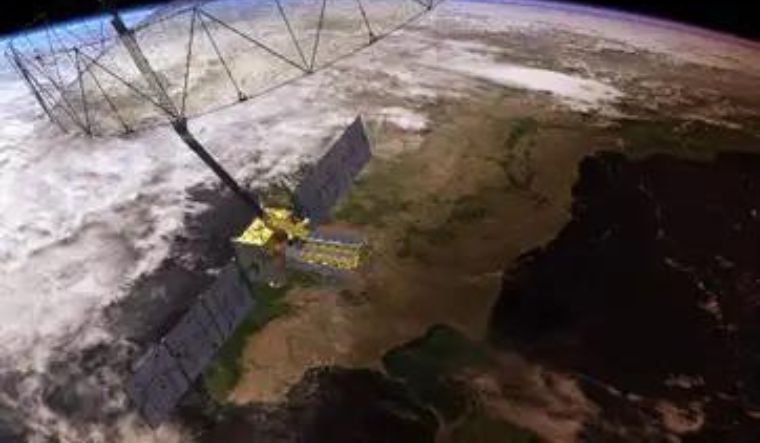The collaborative mission between the National Aeronautics and Space Administration (NASA) and the Indian Space Research Organisation (ISRO), known as NISAR (NASA-ISRO Synthetic Aperture Radar), is facing a minor setback. The new timeline for the mission’s launch readiness will be determined by the end of April. NISAR represents the inaugural joint venture in satellite hardware between NASA and ISRO focused on observing Earth.
The satellite is nearing its launch phase at the Satish Dhawan Space Centre located on the southeastern shoreline of India. One of the last key steps before launch involves coating the 39-foot (12-meter) diameter drum-shaped radar antenna reflector, a vital part of the satellite provided by NASA with a protective layer. This step is essential to safeguard the antenna from potential temperature-related issues that could affect its functionality once it is in orbit.
“ISRO’s latest assessments indicate that the reflector could be exposed to temperatures above initial projections while folded during transit. In the light of this, the extra protective measure has been deemed necessary,” explained space expert Girish Linganna.
The objective of the NISAR project is to transform the comprehension of terrestrial transformations by deploying microwave signals to survey the planet’s landmasses and ice regions with a 12-day recurrence. The mission anticipates delivering critical, detailed observations on the dynamics of ice sheets, vegetation expansion and geological phenomena, including seismic and volcanic activities.
“The specialised coating, engineered to deflect solar radiation and thereby control temperature spikes, is currently being applied in a dedicated facility in California. This step necessitates transporting the reflector from ISRO’s assembly location in India, underscoring the collaborative essence of the mission,” added Linganna.
The NISAR satellite, after it arrived in India on March 6 last year, underwent a series of examinations at the UR Rao Satellite Centre in Bengaluru. Before being transported for further testing in India, NISAR was assembled and evaluated at NASA’s Jet Propulsion Laboratory (JPL) in California. Following confirmation of the coating’s ability to manage heat, the reflector is slated to be sent back to India to be affixed to the satellite, signifying one of the concluding phases before the satellite’s deployment.
The satellite is equipped to provide unparalleled observations of Earth’s changing landscapes by leveraging the capabilities of both L-band and S-band synthetic aperture radars. Its mission scope covers the surveillance of glacial shifts, assessment of wetlands and forested areas and the study of land surrounding pivotal geological formations.
“Similar projects have experienced postponements due to a range of factors—including technical difficulties, adverse weather, or unexpected complications. Every mission has its distinct set of challenges that can lead to schedule changes. Therefore, it is crucial to keep abreast of announcements from the respective space organisations for the latest information on launch dates and mission progress,” said Linganna.
NISAR is scheduled to be launched into space aboard ISRO’s Geosynchronous Satellite Launch Vehicle Mark-II rocket from the Satish Dhawan Space Centre in Sriharikota. The satellite is designed to be placed in a near-polar Earth orbit at an altitude of 747 kilometres. It will conduct observations while orbiting Earth, completing one full orbit every 12 days. According to NASA, the satellite is constructed to operate for a minimum duration of three years.
NISAR marks a significant milestone as the inaugural Earth science spacecraft collaboration between NASA and ISRO. It stands as one of the largest cooperative efforts between the two agencies, with NASA investing over $1 billion solely in the mission’s formulation and development. The collaboration entails NASA contributing an L-band radar and engineering payload and ISRO contributing the S-band payload, spacecraft bus and launch vehicle.
Space experts explain that though specific types of coatings to be done in California for the antenna of NISAR or its components are not publicly detailed in general, satellites like those used in the NISAR project typically use several types of coatings for various purposes.
“There are thermal control coatings which are used to manage the thermal balance of the satellite. They can reflect solar heat, helping to keep the satellite cool, or can be designed to absorb heat where warmth is necessary. Similarly, there are conductive coatings which are used to prevent the build-up of static electricity on the satellite’s surface, which can damage sensitive electronics,” said Linganna.
“There are also optical coatings which are applied to lens elements and other optical components to enhance their performance by reducing reflection or tailoring the transmittance of different wavelengths of light. There are also protective coatings which protect the satellite from the harsh environment of space, including micro-meteoroids, atomic oxygen, ultraviolet radiation and other potentially damaging factors,” he added.



